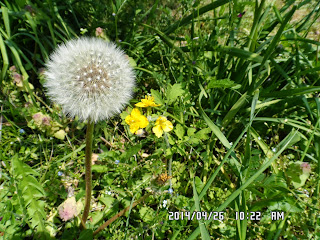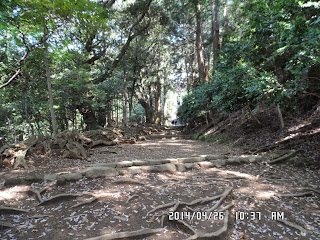Date: April 26 (Sat), 2014, fine
Course:
Public Access: Ofuna – Fujisawa – Isehara – Hinatayakushi
Hiking Course: Bus-Stop – Hinatayakushi – Hinata Bairin – Hinatayama – Hinata Bairin – Bus Stop
After attending Saturday Morning Bible Study, I went to Isehara for a light trekking.
There are two courses available from Isehara. One is to Mt. Ohyama, the other is Hinatayakushi(日向薬師).
There were many people heading for Ohyama. So, I quit going to Ohyama and took a bus to Hinatayakushi.
I visited this temple about 5 years ago. It was under repair construction.
According to the record which this temple holds it was founded in 716 AD by Gyoki, the high ranking monk in Nara Period.
But no remains found inside the temple ground which dated back to Nara Period (710-794), so it was founded during the 10th century.
It is recorded in the historical documents “Azuma Kagami吾妻鏡” that the founder of The Kamakura shogunate (Japanese: 鎌倉幕府, Kamakura bakufu), Minamoto no Yoritomo (源頼朝) visited this temple several times.
He prayed for the safe labor of his wife, Hojo Masako (北条政子) and recovery from the serious sickenss of their daughter Ohime(大姫).
I visited this temple after climbing Ooyama 5 years ago. That time, I walked from the opposite direction. So it was my first time to walk from the main street through the “Sanmon” or “Mountain Gate.”
There are two statutes of “Kongōrikishi (金剛力士)” or “Niō (仁王)” which were made in 1833.
The main path was in the woods of big trees which reminded me of Mt. Haguro in Yamagata prefecture.
The main building of Hinatayakushi was originally built about 1200 years ago. They repaired the temple twice in a big scale.
The first repair was about 630 years ago. The 2nd repair was 350 years ago. Now this 3rd repair will be finished in 2017.
I went through Hinatayakushi and climbed a small mountain called Hinatayama.
There was a plum orchard called “Hinata Baien” at the foot of Hinatayama.
I took a short rest at the table in the orchard.
Then I walked a gentle slope of Hinatayama.
I saw a Japanese striped snake called “Shimahebi(縞蛇)” along the trail.
Then I came to the pass with a guidepost. From this point to the top of the mountain was only 500 m along the ridge.
I arrived at the top of Hinatayama at 11:49. I had lunch there.
There was a small shrine made of stone. Benzaiten was enshrined.
There were two groups of hikers there, but they were all whom I met during the hike.
I went back to the bus stop via diffent trail from Mt. Ohyama via “Shirahige Shrine”
I came back to the bus stop a little after 1 pm.
I came back to Ofuna at around 2:30 pm. So, it was a light easy hike on a fine day.
It was my 4th hike in Japan in April.
----------------------------------------------------------------------------------------
分類:登山、日本、関東,登山、日本、丹沢大山国定公園
登山月日:2014年4月26日(土)、晴れ
登山地:神奈川県、伊勢原市と厚木市にまたがる「日向山(404m)」
現地までのアクセス:大船~藤沢~相模大野~伊勢原
登山コース:日向薬師バス停~日向薬師~日向梅林~日向山~日向梅園~大山下山路~バス停
この日の目的地「日向山」は神奈川県伊勢原市と厚木市の境にある標高404.4mの山である。
日向山と言う名の山は日本中に12カ所もあり、そのうち1000mを超える山は栃木県日光市と群馬県沼田市の境にある標高1695mの山など5カ所ある。
神奈川県伊勢原市の山は404mである。この日は教会で7時から8時まで開催された聖書の勉強・祈り会に参加してからのハイキングなので、近場で軽いところを選択した。
いつもの大山コースで、大船~藤沢~相模大野~伊勢原というアクセスで伊勢原には9時半についた。大山ケーブル行きのバスが非常に混んでいたので、日向薬師行きのバスに乗った。
終点の日向薬師には10時15分ごろ到着した。こちらはガラガラで、ハイカーも数人だった。
日向薬師へ行くのは5年ぶりだ。日向薬師は寺伝によると霊亀2年(716年)、奈良時代の高僧・行基668年-749年)の開山とされている。しかし境内からは奈良時代にさかのぼる寺院跡は発掘されておらず、実際の創建は10世紀頃と推定されている。[Wikipedia]
鎌倉時代には源頼朝の庇護を受け、当時の史書『吾妻鏡』には妻・北条政子の安産祈願のために読経をさせたとか娘の大姫の病平癒祈願のため自ら「日向山」へ参詣したとの記載がある。
バス停から薬師本堂への参拝道はうっそうとした森の中で妻の実家の出羽三山の1つの羽黒山を思わせる。この森林は神奈川県指定の天然記念物になっている。
「衣裳場(いしば)」の説明
仁王門へと上がる階段下辺りは「いしば」と呼ばれている。 源頼朝が日向薬師に参詣の折りに旅装から白装束に着替えたところで「衣裳場」と呼ばれていたが、「いしょうば」が訛って「いしば」となったという。
出典:「日向薬師のいしば衣裳場」http://www8.plala.or.jp/daisho/kamakura/hinata-yakusi-isiba.htm
参道を10分ほど進むと山門があり、この山門を守る仁王像(金剛力士像)は立派で、1833年の作である。
本堂は4年前から「平成の体修理」が始まっていた。この本堂は約350年ごとに修理をしているそうで、最初の大修理は1380年、2度目の修理は1660年であり、今回は3度目の修理である。
今回の修理の完成は平成29年、2017年を予定していて、その時にはまた訪れてみたい。
さて、日向薬師を抜けると裏には梅林がある。日向梅林といい、昭和50年(1975年ごろ約100本の梅の木が植えられたそうだ。
この梅林にはベンチとテーブルがあり、ここで1回目の休憩をとった。
日向山はこの梅園が入り口であり、気持ちの良い登山路がなだらかに登っている。
広沢寺温泉まで3.1kmという里程標を過ぎた地点で意外と大きなシマヘビを見かけた。
「クマ出没注意」の看板と梅の木尾根・日向山の十字路の標識地点から尾根歩きとなり、涼しい風が吹く尾根を500m進むともうそこが日当山頂上であった。
頂上には小さな石洞があり、弁天様が祭られている。「ナイスの山」山頂ともあり、弁天様は水の神様とされているそうだ。
ここで二度目の休憩を取り、昼食を食べた。周囲には二人連れのハイカーと3人連れのハイカーの2組のハイカーたちがいた。そのほかにハイカーはいなかった。
その後、梅林まで戻ってから、林道を進んで大山方面からの下山路を歩いて日向薬師バス停へ戻った。
この時期は何処を歩いても花が多く、気持ちの良いトレッキングである。途中で韓国では「トゥングルレ둥굴레」と呼ばれ、その根っこを乾かしてお茶にする、「アマドコロ」の花を見た。ウィキペディアによると学名は"Polygonatum odoratum"と言い、"angular Solomon's seal" とか"scented Solomon's seal"とも呼ばれるらしい。
途中、バス停のそばには渡来人にかかわる「白髯神社」がある。この神社の御祭神は高麗王若光、熊野権現で、社伝によれば新羅と百済に攻め滅ぼされた高句麗の王族・若光が日本に亡命。東国開発の勅命を受けて大磯に上陸し、その後この日向に落ち着いたといわれている。(下記ブログ参照)
白髯神社の詳細を説明するブログ:↓
http://5.pro.tok2.com/~tetsuyosie/kanagawa/iseharasi/sirahige/sirahige.html
午後1時半のバスに乗って伊勢原へ戻り、2時半には大船へ戻った。
日本へもどってから4月にはいって4回目のハイキングである。
I like hiking very much. I used to go hiking with a Korean hiking club named “AhToSan.” This blog introduces mostly my hiking activities in Korea and Japan, and Sydney in Australia. As of January 2020, I live in Sydney suburb. I go Blue Mountains and bush walk in Sydney area. 私は2003年から2014年まで韓国の大田(テジョン)に住んだ日本人である。11年間、週末は主に「アトサン山岳会」に参加した。14年4月に帰国したが、2020年以降はおもにシドニーで暮らし、時折、日本へ帰国する程度である。したがって最近の記事はSR(Sydney Report)としてブルーマウンテンのトレッキングを中心に書いている。
About pictures/当ブログ内の写真について/당 블로그내의 사진에 대해서
Most of the pictures in this blog are taken by my camera, yet some of them were downloaded from the website of the hiking club. If you click any pictures, they become the original size.
当ブログ内の写真の大部分は筆者のカメラで撮影したものですが、一部、山岳会の共有写真からダウンロードしたものを含みます。すべて、各写真をクリックすれば、元のサイズに拡大します。
당 블로그내 사진의 대부분은 필자의 카메라로 촬영한 것입니다만 일부 산악회 공유 사진으로부터 다운한 것도 포함합니다. 모두 각 사진을 클릭하면, 원래 사이즈에 확대합니다.
当ブログ内の写真の大部分は筆者のカメラで撮影したものですが、一部、山岳会の共有写真からダウンロードしたものを含みます。すべて、各写真をクリックすれば、元のサイズに拡大します。
당 블로그내 사진의 대부분은 필자의 카메라로 촬영한 것입니다만 일부 산악회 공유 사진으로부터 다운한 것도 포함합니다. 모두 각 사진을 클릭하면, 원래 사이즈에 확대합니다.


























































0 件のコメント:
コメントを投稿